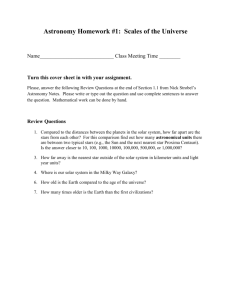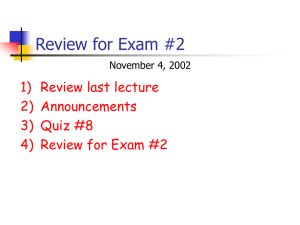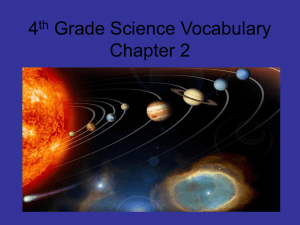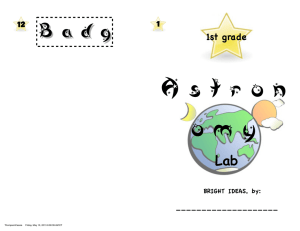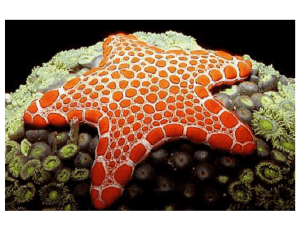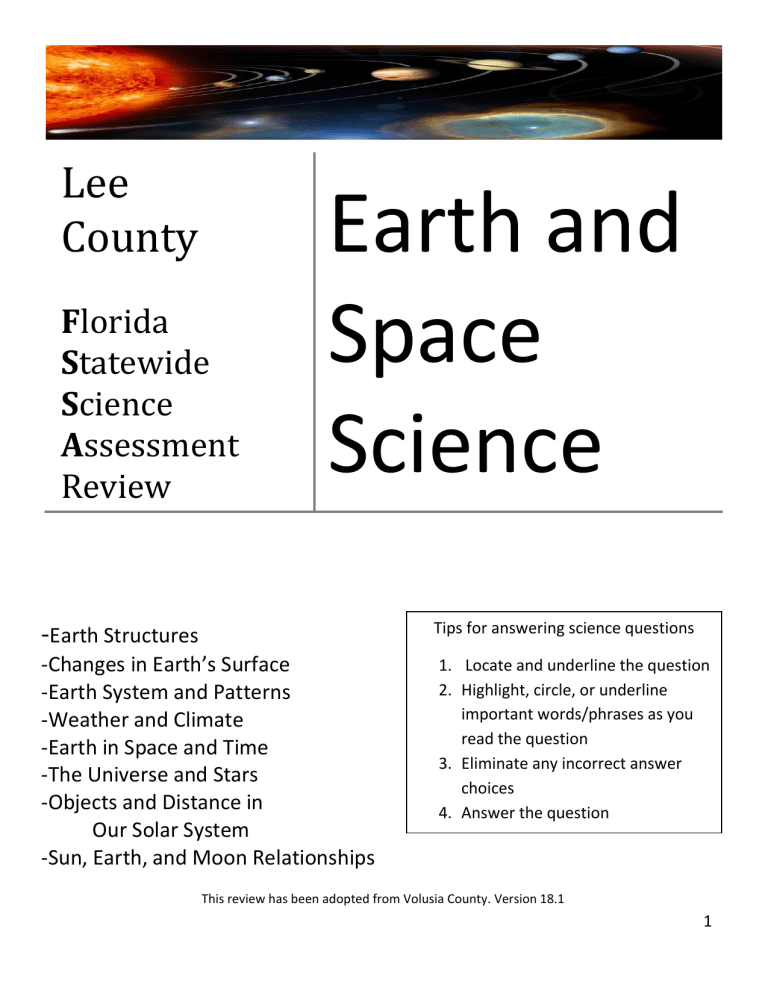
Lee County Florida Statewide Science Assessment Review Earth and Space Science -Earth Structures Tips for answering science questions -Changes in Earth’s Surface -Earth System and Patterns -Weather and Climate -Earth in Space and Time -The Universe and Stars -Objects and Distance in Our Solar System -Sun, Earth, and Moon Relationships 1. Locate and underline the question 2. Highlight, circle, or underline important words/phrases as you read the question 3. Eliminate any incorrect answer choices 4. Answer the question This review has been adopted from Volusia County. Version 18.1 1 Earth’s Spheres The atmosphere is the envelope of gasses that forms Earth’s outermost layer. Nearly all of Earth’s mass is found in the geosphere. The cryosphere consists of all water in the form of ice on Earth. The biosphere contains all living organisms and the hydrosphere includes 75% of the entire Earth, which is covered in water and water vapor. Label the spheres in the image to the left. Glacier The Hoover Dam (left) is a great example of interactions within Earth’s spheres. Below explains all of the interactions occurring. Label which “sphere” is being discussed in each interaction. Humans (______________) built a dam out of rock materials (______________). Water in the lake (__________________) seeps into the cliff walls behind the dam, becoming groundwater (__________________), or evaporating into the air (_____________________). Humans (______________________) harness energy from the water (____________________) by having it spin turbines to produce electricity. Earth’s Atmosphere The _____________________________ is the lowest layer of the atmosphere and is where the Earth’s weather occurs. Directly above this layer is the _________________________, which contains the ozone layer. The ozone layer absorbs UV Radiation from the sun, causing this layer to ____________________ in temperature. The mesosphere is the next layer up and protects the Earth’s surface from meteoroids. The __________________ is the part of the atmosphere furthest from the surface. If the atmosphere was compromised, how would this affect life? _____________________________________________________ _____________________________________________________ _____________________________________________________ _2 Landforms Identify the landforms in the images below. Each image may have more than 1 landform including coastline, delta, mountains, dunes, rivers, lakes, and glaciers. Sinkhole Demo Poke a hole in the middle of a Styrofoam bowl, and place an antacid tablet on top. Place clay around the tablet and fill the bowl with sand. Pour water into the bowl. Over time the water will break down the tablet, and make a sinkhole. What layer of rock does the antacid tablet represent? The image to the right is the Florida Caverns, located in Marianna, Florida. Much of Florida rests over layers of limestone and dolomite. Over thousands of years, trickling water slowly erodes away the rock, creating caves and caverns. The Florida aquifer system is one of the largest in the world, expanding 100,000 square miles. An aquifer is a body of saturated rock through which water can easily move. Why do you believe Florida has such a robust aquifer system? ________________________________ ______________________________________ 3 Changes in Earth’s Surface When rock is broken down into smaller pieces, we call it physical weathering. Chemical weathering is the process that breaks down rock through chemical changes. Below, place a P on the line if it is an agent of physical weathering, and a C if the process represents chemical weathering. ___Freezing/thawing ____Acid Rain ___Animal Actions ___oxidation ___Abrasion ___Water ___Carbon Dioxide Rock particles that are picked up and transported by one of the eroding agents will ultimately be deposited somewhere else, and agents of erosion become agents of deposition. Final deposition of particles (sediments) usually occurs at the mouth of a stream. This is due to the faster flowing stream emptying into a slower, larger body of water. Using the image on the right, identify where erosion (E) and deposition (D) would most likely occur. The graph to the left is showing how the rate of deposition in relation to the shape of the particle. How does the particle shape effect the rate of deposition? __________________________________________________________ __________________________________________________________ __________________________________________________________ Human Impact: Match the human impact effect with the process Deforestation Desertification Urbanization Changing the flow of water a. A population shift from rural to urban areas. b. The creation of levees which can result in the flooding of a river basin. c. When relatively dry land region becomes increasingly arid, typically losing its bodies of water as well as vegetation and wildlife. d. The process whereby natural forests are cleared through logging and/or burning, either to use the timber or to replace the area for alternative uses. In what ways would deforestation impact our natural environment? 4 The Water Cycle The water cycle is a continuous process by which ______________ moves from Earth’s surface to the atmosphere and back again. This cycle is driven by energy from the _______________ and by the force of __________________________ . What role does the sun play in our water cycle? ______________________________________ ______________________________________ Label the water cycle using the following terms: evaporation, condensation, transpiration, percolation, and precipitation How is the water cycle the driving process behind weathering, erosion and deposition? _____________________________________________________________ _____________________________________________________________ How might the cycling of water between the atmosphere and hydrosphere affect weather patterns and climate? _____________________________________________________________ _____________________________________________________________ 5 Energy Transfer and Heating of Earth The picture to the left is showing a weather event. What event is occurring? _________ __________________ SUN Y W Z What do the arrows represent? _________ __________________ X Land Ocean The Sun’s energy is heating the Earth, including the land, oceans, and atmosphere. The diagram above shows part of this process. Draw arrows showing the circulation of heat from land to ocean. Circle What does the dotted line represent? _____ __________________ What type of front is shown in the picture? __________________ the letter where the sun’s heat would be at a maximum? Why does air move in both of the above diagrams? _______________________________________________ __________________________________________________________________________________________ The arrows in the picture below show several ways heat is transferred from the Sun as it strikes the sand on the surface of a beach. Name the heat transfer and explain why it is associated with each arrow. 1. _____________________ because _______________ ______________________________________________. 2. _____________________ because _______________ ______________________________________________. 3. _____________________ because _______________ ______________________________________________. 4. _____________________ because _______________ ______________________________________________. 6 Weather and Climate The conditions of the atmosphere at a particular time and place are called weather. Weather is measured through temperature, air pressure, wind direction and speed, humidity, and precipitation. All of these factors determine the weather of an area. Changes in Earth’s systems influence local weather. Air pressure is the result of the weight of air pushing down on an area. When air pressure is high, fair weather is coming. When air pressure is low, stormy weather is coming. When air pressure is steady, the weather will likely continue. The World Map above shows the ocean currents on Earth. The temperature of the water at the equator would be (circle) hot / cold. Find Europe on the map above. Great Britain (England) is located along the northern coast of the Atlantic Ocean (a little to the left of the word Europe). How do the ocean currents affect the climate of the region? __________________________________________________________________________________________________ __________________________________________________________________________________________________ Highlight the Gulf Stream on the map above. How does the Gulf Stream impact the climate along the costal USA? __________________________________________________________________________________________________ __________________________________________________________________________________________________ Jet streams are a band of high-speed winds about 10 km above Earth’s surface. Jet streams normally move from west to east (as shown in the picture to the left) along the boundary of warm and cold air masses. On the picture to the left, describe the typical weather conditions that would occur above the jet stream, and the typical weather conditions that would occur below the jet stream. 7 Weather and Climate The typical weather pattern in an area over a LONG period of time is called the climate. Which of the following statements is an explanation of an area’s climate? a. There should be heavy rains tomorrow morning. b. The rains next week may cause some flooding c. The average temperature from 19902000 was 23°C d. The high temperature for the area is 33°C. Differentiate climate and weather. How are they alike? How are they different? _____________________________ _________________________________________________ _________________________________________________ _________________________________________________ Using the picture of Massachusetts to the left, explain a plausible reason for the cooler temperatures on the bottom and right side of the map, and the warmer temperatures on the top left. Please note that the viewable region is around 100 miles east to west. ___________________________________________________ ___________________________________________________ ___________________________________________________ Fronts affect the daily weather on a particular region. Using the image to the left as a guide, predict the type of weather you would expect when encountering one of these fronts. Cold Front: Warm Front: Stationary Front: Occluded Front: 8 Earth’s Geosphere Label the interior of the Earth on the image to the left using the following words: mantle, inner core, crust, outer core, and lithosphere Pressure will (circle one) increase / decrease as you move towards the center of the Earth. They do what!? Radioactive Dating In order to date an artifact, the amount of Carbon14 is compared to the amount of Carbon-12 (the stable form of carbon) to determine how much has decayed. The ratio of carbon-12 to carbon-14 is the same in all living things. However, at the moment of death, the amount of carbon-14 begins to decrease because it is unstable, while the amount of carbon12 remains constant in the sample. Half of the carbon-14 degrades every 5,730 years as indicated by its half-life. By measuring the ratio of carbon-12 to carbon-14 in the sample and comparing it to the ratio in a living organism, it is possible to determine the age of an artifact. How does the image above support the Law of Superposition? Write to explain how scientists use relative dating to see farther back in time. _________________________________________________________________ _________________________________________________________________ _________________________________________________________________ _________________________________________________________________ Compare and contrast the benefits of Radioactive Dating and Relative Dating. _________________________________________________________________ _________________________________________________________________ 9 Plate Tectonics The map above shows the plates on the Earth. Earth’s plates meet at areas called ______________ ___________________. There are three different ways the plates can move along these areas. Movement of Earth’s crustal plates can cause both fast and slow changes in Earth’s surface. An example of a fast change in Earth’s surface is _____________________________. An example of a slow change in Earth’s surface is ______________________________. What is Pangaea? ______________________________________________________________ What does the Theory of Plate Tectonics state? _____________________________________________________________________________ Name the diagrams below: Transform, Divergent, or Convergent Write what type of landform(s) commonly forms at each boundary. Name: Landform: 10 Name: Landform: Name: Landform: Rock Cycle The rock cycle is a series of processes that occur on Earth’s _____________ and in the crust and ________________ that slowly change rocks from one kind to another. The rock cycle relates to surface and subsurface events. Surface events refer to the __________________, erosion, and ___________________ of the Earth. Sub-surface events refer to ___________________ and mountain building. Label the Rock cycle with the correct term: melting, weathering and erosion, heat and pressure, cooling, and deposition. Something to think about… Do all rocks go through every part of the rock cycle? _______________ ____________________________ What evidence helped you decide your answer? ________________ ____________________________ ____________________________ Explain how weathering and erosion helps change rocks within the rock cycle. _________________________________________________________________________ _________________________________________________________________________ Explain how plate tectonics and mountain building change rocks within the rock cycle. _________________________________________________________________________ _________________________________________________________________________ 11 Size of the Universe and Gravity ___ Earth to our closest star, the Sun ___ Earth to our next closest star, Proxima Centuri ___ Earth to the furthest planet in our solar system, Neptune ___ Earth to the Eagle Nebula ___ Earth to Charon, Pluto’s moon An astronomical unit is equal to the distance from the Sun to the Earth, whereas a light year is used to measure large distances and is the distance light travels in one year. In the box to the left, place an AU next to the objects you would measure distances in astronomical units, and an LY next to the objects you would measure in light years. The points on the chart below represent the approximate size of objects in the universe. The approximate size of the solar system is labeled. Below, label the Earth, The Milky Way, the Moon and the Sun. ___ Earth to the Hale Bopp Comet Below are images of the 3 different types of galaxies including spiral, irregular, and elliptical. Identify each type of galaxy shown below. The image above is the Hubble Ultra Deep Field. First developed in 2004, every dot seen represents an entire galaxy. What could we conclude about our universe after viewing this photo?_____________________ ______________________________ _ _____________________ 12 Newton's law of universal gravitation states that any two bodies in the universe attract each other with a force that is directly proportional to the product of their masses and inversely proportional to the square of the distance between them. Which has a larger effect on gravitational attraction, distance or mass? ___________________________________________________ ___________________________________________________ _____________________________________________ _____________ What role does gravity Compare and contrast the play in the formation of images of the Heliocentric planets, solar systems and Geocentric Mode and galaxies? (left). ____________________ _____________________ ____________________ _____________________ ____________________ _____________________ ____________________ _____________________ ____________________ _____________________ ____________________ _________ ____________________ ____ Stars Below, the HR Diagram shows that stars on the _________________________ are the hottest stars. Stars on the top of the graph are ______________________________ than the stars on the bottom. 90% of known stars lie along the ______________ ___________________ section in the middle of the HR Diagram. The color of the star allows astronomers to determine a stars ______________________________. Does the HR Diagram allow astronomers to classify stars according to their size? ______ How do you know?____ ____________________ ____________________ What information does the HR Diagram tell you about our star, the Sun?________________ ____________________ ____________________ ____________________ ____________________ Apparent and Absolute Brightness The three stars Alnitak, Alnilam, and Mintaka (shown to the left) in the constellation Orion all have the same apparent brightness from Earth. However, Alnilam is actually farther away than the other two stars. A star’s color reveals its surface temperature. The coolest stars, with a surface temperature of about 3,200 degrees Celsius, appear ___________________ in color. The hottest Stars, with a surface temperature of over 20,000 degrees Celsius, appear ___________________ in color. Our sun has a surface temperature of about 5,500 degrees Celsius and appears ___________________ in color. Knowing this, which star has the greatest absolute brightness? _______________________________ How do you know?________________ ________________________________ ________________________________ ________________________________ ________________________________ 13 Our Sun The innermost layer of the sun is called the core. Here, hydrogen atoms are combined through a process called ___________ to form Helium. The Radiation Zone is an extremely dense area where energy is transferred as electromagnetic radiation. The convection zone is the outermost layer of the sun’s interior. In this zone, hot gas __________ and cooler gases _________ towards the center, forming loops of gas that move energy towards the surface. The following 3 layers make up the solar atmosphere. The photosphere is the layer that is visible to humans, while the chromosphere is the region directly above it. Lastly, the corona is the area of the sun visible during a solar eclipse. This area extends into space for millions of kilometers and gradually streams into charged particles known as the solar wind. Our star, the sun is a main sequence star, and is about 5 billion years old. Due to its size, it will become a red giant in about 5 billion years, consuming the orbits of Mercury, Venus and Earth. The sun will NOT go supernova since it is not massive enough! The image to the right shows a two-week time lapse of a sunspot on the surface of the sun. We know that sunspots are cooler regions on the sun and are caused by intense magnetic activity. From the image, what can we conclude about the sun’s movement? _____________________________________ _____________________________________ _____________________________________ Huge loops of gas called prominences often link different parts of sunspot regions. When the gas erupts and spreads out into space, it becomes a solar flare. Earth’s magnetic field helps shield us from this activity. The image to the left is an example of a ______________________________________. 14 Objects in Our Solar System As you get further away from the sun, the light intensity decreases. The data table to the left shows the average surface temperature of 6 planets in our solar system. What would be a plausible reason for Venus to have a higher temperature than Mercury? ____________________________________________ _____________________________________________________ _____________________________________________________ _____________________________________________________ In order for an object to be considered a planet, it must orbit a star, have enough mass to maintain a spherical shape and clear its orbital path of all similar sized objects. Below is a data table showing a series of objects in our solar system. Of the below objects, which are planets? Which are moons? How do you know? Object Orbits Distance from Star (au) 1 2 3 4 5 6 7 8 Star Star Planet Star Star Star Star Planet 0.7 1.0 5.4 30.4 3.0 5.4 20.1 1.0 Shape Diameter (km) Moons Orbital zone clear of similarsized objects? Round Round Round Round No Round Round Round 12,100 12,700 5,262 49,528 54 142,984 51,118 3,474 No Yes No Yes No Yes Yes No Yes Yes No Yes No Yes Yes Yes Answers Halley’s Comet (left) is one of the world’s most famous comets. Last seen by Earth in 1986, it will not make it back towards Earth until 2061. A comet is a loose collection of ice and dust that orbits the sun. Using the image on the right as a guide, why do you believe it takes 75 years for the comet to orbit the sun? __________ _________________________________________________________ _________________________________________________________ _________________________________________________________ Classify the following objects below as either IN our solar system or OUT of our solar system. Moons_____ Comets ______ Planets ______ Nebulae ______ Stars other than the Sun ______ 15 Sun, Earth, and Moon Relationships The Earth __________________________ once about its axis every 24 hours and _______________________ around the Sun every 365.25 days. On the image to the right, identify where the equator is located along with drawing an arrow showing the direction of Earth’s rotation. The graph to the left shows the average temperature over a year in the Northern and Southern Hemisphere. The dark line represents the Northern Hemisphere, while the grey line represents the Southern Hemisphere. How does the tilt of Earth’s axis influence the inverse relationship on the graph?___________ _________________________________ _________________________________ _________________________________ Identity the Moon Phases Below Sunlight coming from this direction In the diagram above, when would we experience a spring and neap tide? Why? ______________________________________ _____________________________________________________ 16 In the image to the right, identify (by drawing) where the moon would be in a solar and lunar eclipse. Remember, a solar eclipse occurs when the moons shadow hits Earth and a lunar eclipse occurs when Earth blocks sunlight from reaching the moon. Remember, eclipses don’t occur every month due to the moon’s 5.15 degree titled orbit. *All included diagrams and images are public domain and used for educational purposes only.
